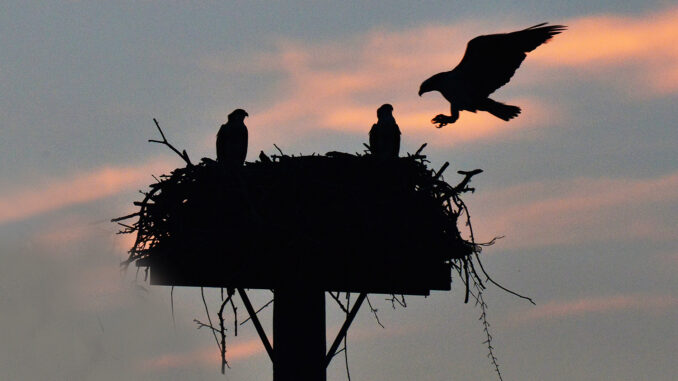
Attention, ospreys of the East End: You are being watched.
Group for the East End, along with a squad of birders and volunteers, is conducting a survey of the hundreds of osprey nests on the North and South forks and Shelter Island. They’re checking to see whether the birds are healthy and producing families on schedule.
“Right now, the ospreys are doing well,” reports Jen Skilbred, senior environmental specialist with the group. “They’ve come back from the brink.”
This is very good news for the winged symbol of the East End, the beautiful sea hawks we see on their tall nesting perches or sweeping over our bays and inlets.
A sure sign of the change of season is the return of the ospreys to the East End. This homecoming usually coincides with the beginning of spring. Males often are the first to return to stake their claims to nests, while females don’t seem to have the same attachment to the nesting sites. But the females often do mate with the same male from year-to-year.
While the older ospreys fly south to Florida each winter, young ospreys have been known to migrate to the Caribbean and South America.
Most tend to stay on the island here until August, with a few remaining as late as October. Cold winter temperatures interfere with the food supply here, urging the birds to southern climes.
Group for the East End, an environmental advocacy nonprofit, has been counting the osprey population for 30 years. It used to be done annually, but now it’s every three years.
Ospreys were listed as an endangered species in 1976, due to exposure to pesticides and out-of-control development. They’re no longer considered endangered, thanks to efforts like the Group’s installation of 250 new nesting platforms.
“We’re just keeping an eye on things,” said Ms. Skilbred.
This year’s census began Memorial Day weekend and ran for two weeks. That campaign was to count the number of active nests, meaning ones with potential parents in residence.
About 200 have been logged so far. Phase Two will continue into mid-July, when fledglings have grown big enough to be spotted from a distance. The count is still going on, but in the last census, volunteers recorded 353 active nesting pairs that produced 505 fledglings. That included 136 active nests in Southold and 25 in Riverhead.
“Right now, the numbers are looking very good,” said Ms. Skilbred. She explained volunteers are key to assembling the data, which will be logged into a state database and, she hopes, compared with similar data from Connecticut.
The survey is also a big deal for the all the grade school kids who take part in the hiking and the sometimes long waits to spot the residents of the nests.
“It gets the kids out here to appreciate this beautiful place,” said Ms. Skilbred. “It’s a bit of a hike, and it takes patience, but it’s worth it.”

